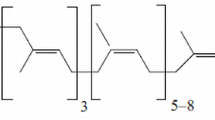Abstract
The mitogenic effects on mouse spleen lymphocytes were determined in a large series of commercially available and laboratory-prepared lipopolysaccharides (LPS) obtained fromEscherichia, Salmonella, Serratia andShigella species; part of these LPS preparations was chemically modified prior to testing. In order to establish whether the degree of mitogenic activity corresponds with other biological effects of these preparations, polyclonal activity, capability to induce specific antibody formation and toxicity were determined for selected LPS's with different mitogenic effects. Some of the detoxication procedures used succeeded in reducing the toxicity of LPS while preserving its high mitogenic activitione of the Fe-detoxified preparations of LPS (from the R-form ofShigella dysenteriae serovar 1) exhibited a medium-degree efficacy in all parameters studied. Generally, there was no correlation between the degree of mitogenic activity and the polyclonal and antibody-inducing activities, but in some instances polyclonal activity did correlate with the antibody-inducing activity.
Similar content being viewed by others
References
Bartók L.: Stimulation of nonspecific resistance by radiodetoxified endotoxin, Abstr. 2165 at14th Internat. Cancer Congress, Budapest 1986.
Chedid L., Audiberts F., Bona C.: Adjuvant and mitogenic effects of detoxified lipopolysaccharides.Compt. Rend. Acad. Sci. (Paris) 280, 197–200 (1975).
Dukstra J., Mellors J.W., Ryan J.L., Szolka F.C.: Modulation of the biological activity of bacterial endotoxin by incorporation into liposomes.J. Immunol. 138, 2663–2670 (1987).
Galanos C., Freudenberg M.A., Reutter W.: Galactosamine-induced sensitization to the lethal effects of endotoxin.Proc. Nat. Acad. Sci. 76, 5939–5943 (1979).
Hinshaw L.B.: Pathophysiology of endotoxin, in R.A. Proctor (Ed.):Handbook of Endotoxin, Vol. 2. Elsevier, Amsterdam 1985.
Hofman J., Pospíŝil M., Mára M., Hříbalová V.: Phenol-water extracts of gram-positiveListeria monocytogenes and gram-negativeSalmonella typhimurium. Comparison of biological activities.Folia Microbiol. 30, 231–236 (1985).
Jerne N.K., Nordin A.A.: Plaque formation in agar by single antibody-producing cells.Science 140, 405 (1963).
Johnson, A.G.: Immunomodulation by microbial products, Abstr. 2167 at14th Internat. Cancer Congress, Budapest 1986.
Kotani S., Takada H., Takahashi I., Ogawa T., Tsujimoto M., Shimauchi H., Ikeda T., Okamura H., Tamura T., Harada K., Tanaka S., Shiba T., Kusumoto S., Shimamoto T.: Immunobiological activities of synthetic lipid A analogs with low endotoxicity.Infect. Immun. 54, 673 (1986).
Martin W.I., Marcus S.: Detoxified bacterial endotoxins. I. Preparation and biological properties of an acetylated crude endotoxin from Salmonella typhimurium.J. Bacteriol. 91, 453–1459 (1966).
Niwa M., Milner K.C., Ribi E., Rudbach J.A.: Alteration of physical, chemical and biological properties of endotoxin by treatment with mild alkali.J. Bacteriol. 97, 1069–1077 (1969).
Nowotny A.:Beneficial Effects of Endotoxins. Plenum Press, New York 1983.
Onozaki K., Hashimoto T.: Different mechanisms of macrophage activation with guinea pig macrophage activation factor, lipopolysaccharide and muramyl dipeptide.Int. Arch. Allergy Appl. Immunol. 76, 296–301 (1985).
Pier G.B., Markham R.B., Eardley D.: Correlation of the biologic responses of C3H/HeJ mice to endotoxin with the chemical and structural properties of the lipopolysaccharides fromPseudomonas aeruginosa andEscherichia coli.J. Immunol. 132, 347–353 (1981).
Pospíšil M., Dráber P., Hofman J., Nouza K., Klapáčová J.: Effect of immunosuppressive agents on the blastogenic response of mouse spleen T and B lymphocytes. I. Culture conditions and the evaluation system.Folia Biol. 24, 185–198 (1978).
Ribi E., Cantrell J.L., Takayama K., Quereshi N., Petersen J., Ribi H.O.: Lipid A and immunotherapy.Rev. Infect. Dis. 6, 567–572 (1984).
Rietschel E.T., Brade H., Brade L., Brandenburg K., Schade U., Seydel U., Zähringer U., Galanos C., Lüderitz O., Westphal O., Labischinski H., Kusumoto S., Shiba T.: Lipid A, the endotoxic center of bacterial lipopolysaccharides: relation of chemical structure to biological activity.Progr. Clin. Biol. Res. 231, 25–53 (1987).
Sayers T.J., Macher I., Chung J., Kugler E.: The production of tumor necrosis factor by mouse bone marrow-derived macrophages in response to bacterial lipopolysaccharide and a chemically synthetized monosaccharide precursor.J. Immunol. 138, 2935–2940 (1975).
Šourek J., Trnka T., Digeon M., Raynaud M.: Some immunochemical and chemical aspects of S and RShigella dysenteriae 1 endotoxins.J. Hyg. Epidemiol. Microbiol. Immunol. 19, 356–374 (1975).
Šourek J., Tichý M., Levin J.: Effects of certain cations (Fe, Zn, Mg and Ca) on bacterial endotoxins.Infect. Immun. 21, 648–654 (1978).
Šterzl J., Mandel L.: Estimation of the inductive size of antibody formation by plaque technique.Folia Microbiol. 9, 173–176 (1964).
Takayama K., Quereshi N., Ribi E., Cantrell J.L.: Separation and characterization of toxic and non-toxic forms of lipid A.Rev. Infect. Dis. 6, 439–443 (1984).
Tomai M.A., Solem L.E., Johnson A.G., Ribi E.: The adjuvant properties of a nontoxic monophosphoryl lipid A in hyporesponsive and aging mice.J. Biol. Resp. Modif. 6, 99–107 (1987).
Vogel S.N., Madonna O.S., Wahl I.M., Rick P.D.:In vitro stimulation of C3H/HeJ spleen cells and macrophages by a lipid A precursor molecule derived fromSalmonella typhimurium.J. Immunol. 132, 347–353 (1984).
Warren H.S., Chedid L.A.: Strategies for the treatment of endotoxemia: significance of the acute-phase response.Rev. Infect. Dis. 9 Suppl. 5, 630–638 (1987).
Author information
Authors and Affiliations
Rights and permissions
About this article
Cite this article
Ŝourek, J., Svobodová, M., Dvořák, R. et al. Bacterial endotoxins: Comparison of mitogenic, polyclonal, antibody-inducing and toxicity activities. Folia Microbiol 36, 192–197 (1991). https://doi.org/10.1007/BF02814502
Received:
Issue Date:
DOI: https://doi.org/10.1007/BF02814502



